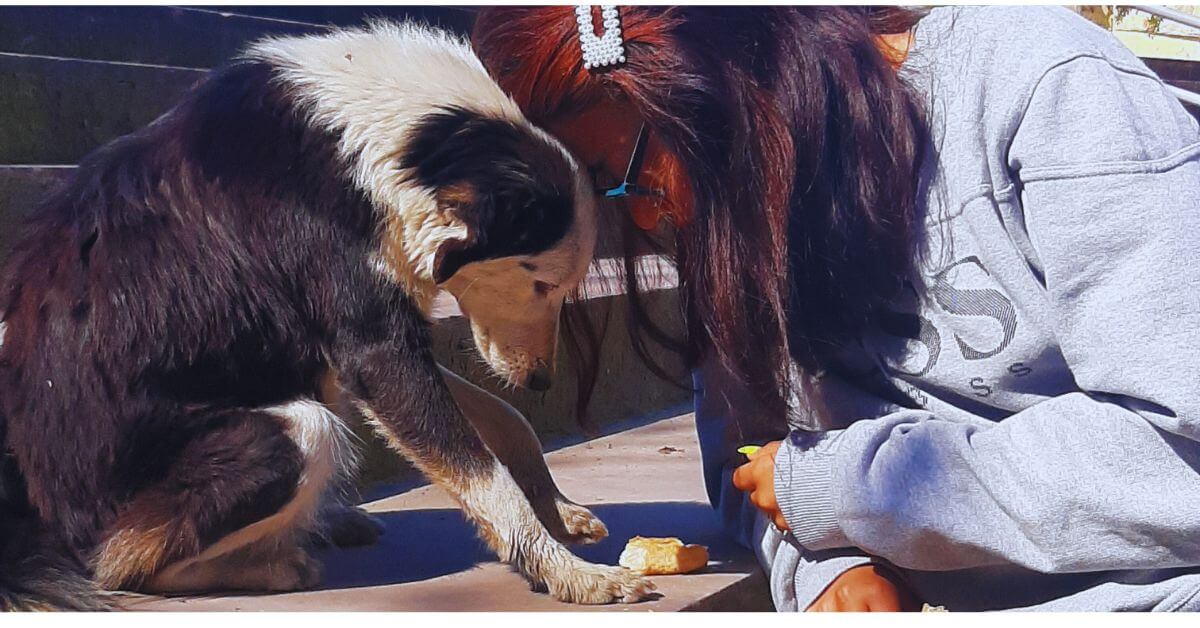Our furry companions give us a warm, tail-wagging welcome. But have you ever wondered how to reciprocate that joy? Greeting a dog isn’t a wag and a pat; it’s an intricate dance of body language, energy, and respect.
In this guide, we’re delving deep into the doggy dictionary to decode the perfect greetings. From tail wiggles to nose boops, we’ve got it all covered. So, let’s roll up our sleeves, grab a handful of treats, and embark on this pup-tastic journey!

How to greet a dog?
Meeting Eye to Eye? Not Quite!
Ever heard the phrase “let sleeping dogs lie”? Well, it’s got a grain of truth. When meeting a dog for the first time, avoid direct eye contact as it may interpret it as a challenge. Instead, a sidelong glance with a soft gaze is like offering a friendly handshake. Sink down to their eye level as it will make you seem less threatening.
Here are some key pointers:
– Keep your eyes soft and relaxed.
– Blink to show you mean no harm.
– Allow the dog to approach you first.
Talk the Talk – Canine Style
Dogs have their own language, and it’s not always in barks and woofs. It’s in the tail position, ear tilt, and even the angle of their bodies. Mimicking a dog’s body language is like speaking their native tongue.
When meeting a dog for the first time, it’s essential to approach them with care and consideration. Speak in a soft and gentle tone. Avoid the common mistake of immediately reaching for the top of their head, as this can be daunting for some dogs.
Approach the dog from the side and look for signs like growling, tail tucking, and raised hairs. These signs mean the dog feels threatened and should not be approached. If the dog seems receptive, extend your hand, allowing them to sniff your fingers first.
When it comes to greeting a dog, adopting the right stance and approach can make all the difference. Stand slightly sideways, extend your hand out from your side with palm down and fingers closed to seem less imposing. This allows the dog to approach and sniff if they feel comfortable.
If you feel the dog is comfortable, begin by gently stroking the side of dog’s face. This gesture helps establish trust and can lead to a lasting canine friendship.
Always be attuned to the dog’s cues and avoid sudden moments – if they pull away, respect their space. Not every dog is keen on strangers touching them, and that’s perfectly okay.
🐾 Pro tip for greeting dogs: Start by offering your fist for a friendly sniff! Then, give gentle chin scratches and side pets. Remember, avoid reaching over or standing tall – it can be intimidating for our furry friends.
Remember:
– A wagging tail, especially when accompanied by a loose body, signals a friendly demeanour.
– Ears forward or slightly tilted is a sign of curiosity and friendliness.
– Slow, gentle movements convey calm and non-threatening intentions.
The Art of the Gentle Pat
Aim for the Sweet Spots
Petting a dog is all about knowing the sweet spots. Start with the chin, chest, or back – these areas are generally well-received by our canine friends. Avoid sudden, aggressive pats as they can be startling.
Here’s the lowdown:
– Chin scratches can be downright magical for most dogs.
– A gentle chest rub is like offering a hug in doggy language.
– Steer clear of the tail, paws, and ears until you’ve built trust.
Watch Your Paws!
In the doggy world, it’s all about dangling paws. When you greet a dog, let them make the first move. Crouching down to their level is like extending an invitation. If they lean in for a cuddle, you’re in the clear!
Top tips:
– Crouch down with an open posture to appear non-threatening.
– Let the dog approach you first before reaching out.
– If they lean in or nuzzle, it’s an invitation for some quality bonding time.
Did you know? Rubbing a dog’s ears can release endorphins, leaving them naturally relaxed and on a happy high! 🐶💫
FAQs – Unraveling Canine Queries
Q: What if the dog seems shy or anxious?
– A: In such cases, it’s best to give them space and let them approach you when they’re comfortable.
Q: Can I greet a dog while they’re eating?
– A: It’s generally advised to give dogs their space during meal times to avoid any potential discomfort.
Q: Are there any signs a dog doesn’t want to be greeted?
– A: Absolutely. Watch for cues like growling, raised fur, or a stiff posture. These indicate it’s best to keep your distance.
Always ask the owner for permission before approach a dog.
Not every dog is exuberant and eager for attention. Some may require a gentler introduction to build trust. Even the most well-meaning dogs can get startled, and it’s vital to consider their individual histories and sensitivities. Remember, while you may be well-versed in canine behavior, a little courtesy goes a long way.
Greeting a dog is an art, a dance, a dialogue without words. It’s about respect, understanding, and building trust. When you see a furry friend, keep these tips in mind. A wagging tail and a happy heart will welcome you!
